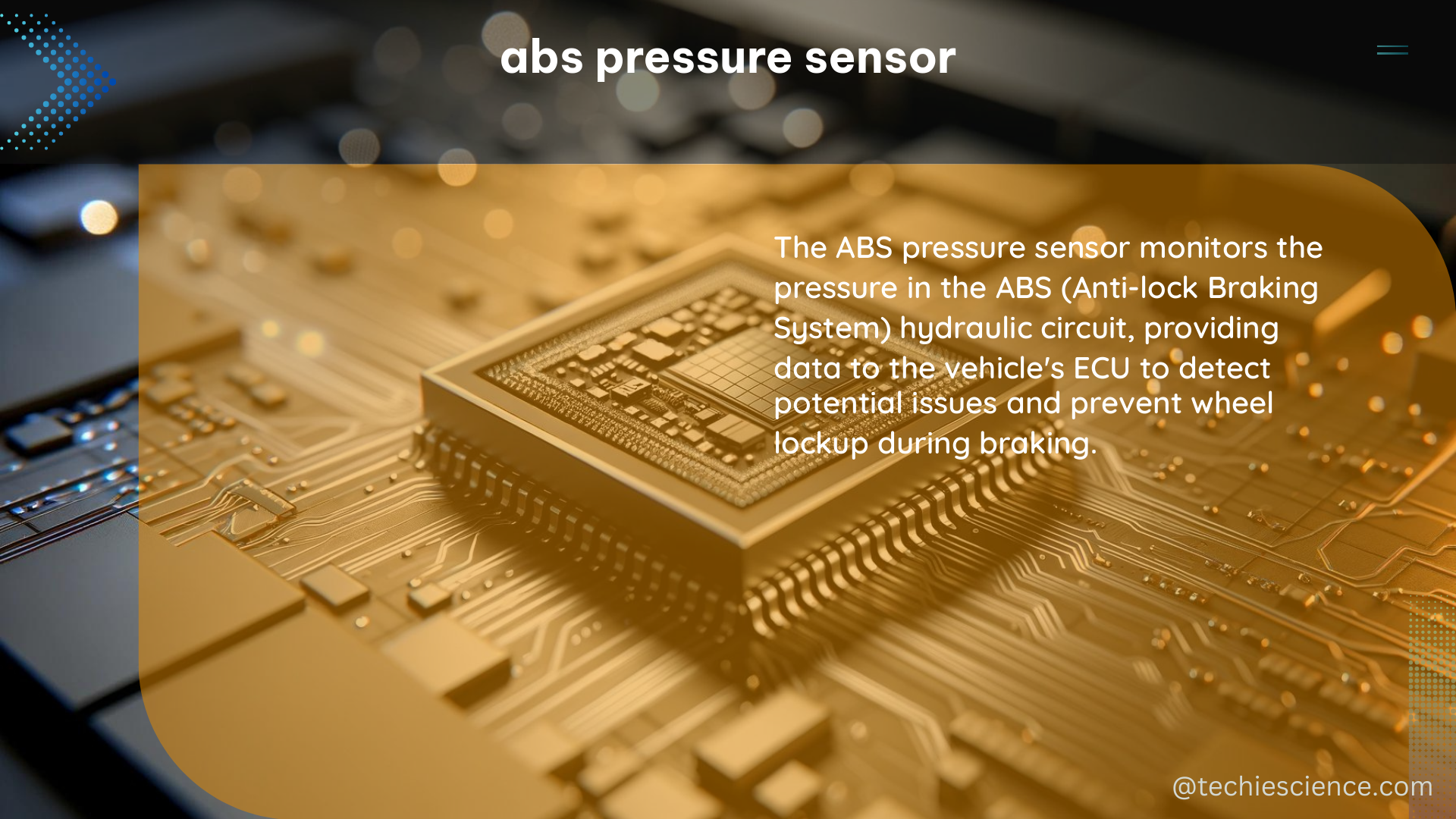The ABS (Anti-lock Braking System) pressure sensor is a critical component in modern vehicles, responsible for accurately measuring the hydraulic pressure within the brake system. This data is essential for the ABS control unit to function correctly, ensuring optimal braking performance and enhanced road safety.
Technical Specifications of ABS Pressure Sensors
Pressure Range
ABS pressure sensors typically have a pressure range of 0 to 100 bar (0 to 1,450 psi) or 0 to 200 bar (0 to 2,900 psi), depending on the vehicle make and model. This wide pressure range allows the sensor to accommodate the high pressures generated during emergency braking situations.
Accuracy
The accuracy of ABS pressure sensors can vary, but they generally have an accuracy of ±1% to ±3% of the full-scale range. This level of precision is crucial for the ABS control unit to make informed decisions and prevent wheel lockup during braking.
Response Time
The response time of an ABS pressure sensor is typically around 1 to 5 milliseconds, ensuring quick and accurate pressure measurements. This rapid response is essential for the ABS system to react swiftly to changing road conditions and driver inputs.
Temperature Range
ABS pressure sensors are designed to operate within a wide temperature range, typically from -40°C (-40°F) to +125°C (+257°F). This broad temperature tolerance ensures reliable performance in various climatic conditions, from extreme cold to scorching heat.
Media Compatibility
ABS pressure sensors are designed to measure the pressure of various media, including brake fluid, hydraulic oil, and other automotive fluids. The sensor’s materials and construction are selected to ensure compatibility and long-term durability in these harsh environments.
Output Signal
ABS pressure sensors typically have an analog output signal, such as 0-5V or 4-20mA, which is transmitted to the ABS control unit for further processing and analysis. This standardized output signal allows for easy integration with the vehicle’s electronic systems.
ABS Pressure Sensor Installation

Installing an ABS pressure sensor requires some technical knowledge and skills. Here’s a step-by-step guide to the installation process:
-
Locate the Brake Lines: Identify the brake lines that run from the brake calipers to the brake master cylinder. This is where the ABS pressure sensor will be installed.
-
Install a T-Piece: Install a T-piece between the brake lines to create a connection point for the ABS pressure sensor. This T-piece should be compatible with the brake line material and diameter.
-
Connect the ABS Pressure Sensor: Securely connect the ABS pressure sensor to the T-piece, ensuring a leak-free and secure installation. Use the appropriate fittings and sealants to prevent any fluid leaks.
-
Connect the Wiring: Route the wiring from the ABS pressure sensor to the ABS control unit, ensuring a secure and reliable connection. Follow the manufacturer’s instructions for proper wiring and grounding.
-
Test the System: Thoroughly test the ABS system to ensure that the pressure sensor is functioning correctly and providing accurate pressure measurements. This may involve using a diagnostic tool or performing a road test.
Troubleshooting ABS Pressure Sensor Issues
If you encounter issues with the ABS pressure sensor, here are some common troubleshooting steps:
-
Check for Diagnostic Trouble Codes: Use a diagnostic tool to scan the vehicle for any ABS-related trouble codes. These codes can provide valuable information about the specific issue with the pressure sensor.
-
Inspect the Sensor and Connections: Visually inspect the ABS pressure sensor and its connections for any signs of damage, corrosion, or loose fittings. Ensure that the sensor is securely installed and the wiring is in good condition.
-
Test the Sensor Output: Use a multimeter to measure the output signal from the ABS pressure sensor. Compare the readings to the expected output range to determine if the sensor is functioning correctly.
-
Check the Brake System: Inspect the entire brake system, including the brake lines, calipers, and master cylinder, for any leaks or other issues that could affect the pressure readings.
-
Replace the Sensor if Necessary: If the ABS pressure sensor is found to be faulty, replace it with a new, OEM-approved component to restore proper ABS functionality.
Conclusion
The ABS pressure sensor is a critical component in modern vehicles, responsible for providing accurate pressure data to the ABS control unit. By understanding the technical specifications, installation process, and troubleshooting techniques, you can ensure the proper operation of your vehicle’s ABS system and maintain optimal braking performance.
References:
- Brake Pressure Sensor for Data Acquisition – Lotus Talk: https://www.lotustalk.com/threads/brake-pressure-sensor-for-data-acquisition.446698/
- Measure the pressure sensor… – GS-911 and ezCAN User Forum: https://forum.hexcode.co.za/forum/index.php?topic=3280.0
- 4 Things to Consider when Choosing a Pressure Sensor – ABB: https://new.abb.com/products/measurement-products/measurement-products-blog/4-things-to-consider-when-choosing-a-pressure-sensor
- Check and change ABS and wheel speed sensors – HELLA: https://www.hella.com/techworld/us/Technical/Sensors-and-actuators/Check-change-ABS-sensor-4074/
- Brake pressure sensor for Data Acquisition? – Grassroots Motorsports: https://grassrootsmotorsports.com/forum/grm/brake-pressure-sensor-for-data-acquisition/70215/page1/

The lambdageeks.com Core SME Team is a group of experienced subject matter experts from diverse scientific and technical fields including Physics, Chemistry, Technology,Electronics & Electrical Engineering, Automotive, Mechanical Engineering. Our team collaborates to create high-quality, well-researched articles on a wide range of science and technology topics for the lambdageeks.com website.
All Our Senior SME are having more than 7 Years of experience in the respective fields . They are either Working Industry Professionals or assocaited With different Universities. Refer Our Authors Page to get to know About our Core SMEs.